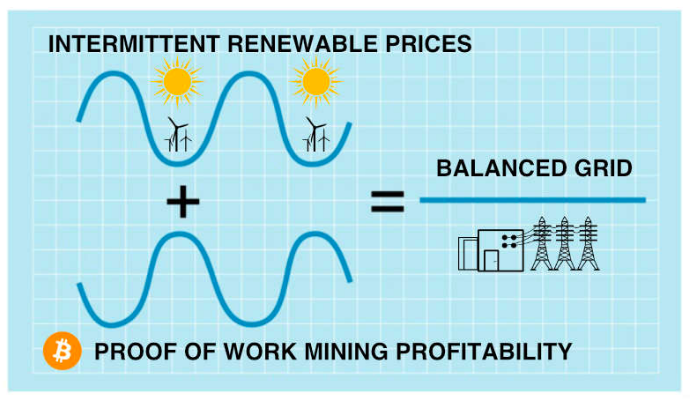This website uses cookies so that we can provide you with the best user experience possible. Cookie information is stored in your browser and performs functions such as recognising you when you return to our website and helping our team to understand which sections of the website you find most interesting and useful.
Grid Stabilization and Bitcoin Mining
Is bitcoin mining an environmental and social good? Energy stability and the ESG case for bitcoin mining
On 12 July 2022, Marathon Digital Holdings tweeted “#Bitcoin miners are a non-rival consumer of power – we can modulate demand as needed and help stabilize the grid.” But what does stabilizing the grid mean? And why is grid stabilization so important to understanding the ESG up-side of bitcoin mining?
Understanding Power Grids
To get to grips with one of the major environmental and social goods of bitcoin, we need to understand a little about how power grids operate. Most people take power grids for granted – when you flick a switch, electricity flows and your appliances simply work. In return for your monthly bill, you usually receive reliable electricity. But, for local utility companies to provide that reliable electricity, extra energy always needs to be available for the whole grid. This means that each grid requires reliable redundancies – extra power – that can be delivered quickly. Therefore, during a heatwave or a big sporting event, everyone can use lots of electricity at the same time without power cuts.
When power generation for the whole grid was from fossil fuels, grid operators could balance the demand and supply of energy relatively easily. As power grids integrate renewables, this becomes more difficult, as renewable energy sources are usually intermittent (wind blows inconsistently, it is not always sunny). Renewables make reliable energy generation more unpredictable and more complicated. Power grids need sources of energy that can be dispatched on demand to deal with electricity demands. This is often natural gas, as it can be brought online quickly and cheaply.


Nuclear, the ‘greenest’ energy source that can be a reliable backup, takes a long time to become available, dispatchable power. Renewable energy can be dispatchable power, but it is not reliable. If a grid relies on hydro-electric power, that power is wasted much of the time. It is possible to use batteries, and they should be part of the solution for long term grid stabilization. But even the world’s biggest battery would not be able to stabilize a large grid during a heatwave.
Bitcoin to the Rescue
Bitcoin mining is an integral part of long-term grid stabilization. Bitcoin mining can transform a nuclear plant or a dam into dispatchable generation by using the extra energy that the grid needs to have available but does not need to use. This is because enterprise bitcoin miners can power down within five minutes. No other technology can respond that rapidly and remain financially sustainable. Even data centers cannot power-down so quickly, as voluntarily interrupting computations is not a viable option. Bitcoin miners merely lose the single block they were computing.


Climate change events, global warming, inconsistent work patterns and COVID19 mean that modern energy supply and demand are continuously in flux. Grid operators increasingly deploy price signals. This allows industries and individual ‘smart’ devices to consume more power when the grid has excess energy, and power down when the grid needs the energy back. Some enterprise and individuals utilize battery technology to buy energy from the grid at night, when cheaper, and use the energy during the day. Despite these efforts, a more centralized solution is needed to prevent large-scale disruption of energy supply in extreme conditions.
The July 2022 Texas heatwave is a great example of bitcoin mining as a grid stabilizer. In July, all time energy usage over the Texas energy grid (ERCOT) reached an all-time high. What saved Texas from potentially life-threatening power cuts and energy disruption was bitcoin mining. Over 1000 megawatts, nearly 1% of the total grid capacity!) was released from mining operations back to the ERCOT grid at a moment’s notice.
This sort of cooperation is not only helpful for grids and bitcoin miners – it can also fuel renewable energy R&D. By monetizing all the energy generated by renewables, bitcoin mining makes investing in new renewables financially viable and enables investors to see quicker returns. Bitcoin mining can also help connect renewables to the grid by transforming the energy generated into dispatchable generation.
With the bear market that began in Q2 2022, profitable bitcoin mining is increasingly consolidated, which helps integrate bitcoin mining into power grids and transform it into a controllable load resource. As climate change makes grid stabilization more and more difficult to achieve, we will likely see a rise in states incentivizing enterprise bitcoin mining operations. In turn, bitcoin mining will power rapid, profitable renewable energy development and a more stable grid.
- https://www.bloomberg.com/news/articles/2022-07-11/bitcoin-miners-shut-off-rigs-as-texas-power-grid-nears-brink#xj4y7vzkg
- https://twitter.com/level39/status/1548550264218583040
- https://energypost.eu/grid-scale-modelling-of-distributed-energy-resources-and-dynamic-pricing-for-all-customers/
- https://hashrateindex.com/blog/bitcoin-mining-controllable-load-resource/
- https://www.sciencedirect.com/science/article/pii/S0360544221019654

